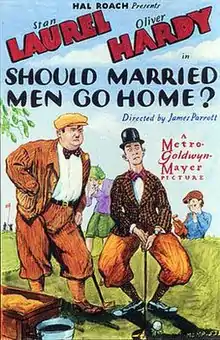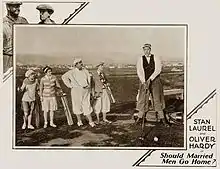Should Married Men Go Home?
Should Married Men Go Home? is a silent short subject co-directed by Leo McCarey and James Parrott starring comedy duo Laurel and Hardy. It was released by Metro-Goldwyn-Mayer on September 8, 1928.
| Should Married Men Go Home? | |
|---|---|
 | |
| Directed by | Leo McCarey James Parrott |
| Produced by | Hal Roach |
| Written by | Leo McCarey James Parrott H.M. Walker |
| Starring | |
| Cinematography | George Stevens |
| Edited by | Richard C. Currier |
| Distributed by | Metro-Goldwyn-Mayer |
Release date |
|
Running time | 20 minutes |
| Country | United States |
| Language | Silent film English intertitles |
Plot
Ollie and his wife are enjoying a quiet Sunday at home until Stan shows up, eager to play some golf. After Stan breaks the Hardys' Victrola and nearly sets fire to their house, Mrs. Hardy chases the boys out. At the golf course, they are partnered with a pair of comely young lasses to complete a foursome. The girls want to be treated to sodas, but the boys are short of money. Stan leaves his watch to settle the thirty-cent bill. On the course, they tangle with rude golfer Edgar Kennedy, and wind up in a mud-throwing battle with several other linksters.
Cast
- Stan Laurel as Stan
- Oliver Hardy as Ollie
Uncredited
- Kay Deslys as Mrs. Hardy
- Edna Marion as Blonde Girlfriend
- Viola Richard as Brunette Girlfriend
- Charlie Hall as Soda Jerk
- Edgar Kennedy as Golfer
- John Aasen as Very Tall Golfer
- Chet Brandenburg as Caddy
- Dorothy Coburn as Muddy Combatant
- Jack Hill as Muddy Combatant
- Sam Lufkin as Shop Manager
- Lyle Tayo as Lady Golfer
Production notes

Should Married Men Go Home? was filmed in March and May 1928. It was the first Hal Roach film to bill Laurel and Hardy as a team. Previous appearances together were billed under the Roach "All-Star Comedy" banner. On-location footage has recently surfaced on YouTube.[1] The film's working title was Follow Through.[2]
8-foot-9 actor John Aasen appears as "Very Tall Golfer."
The soda fountain routine was reworked during the sound era in the film Men O' War, with Jimmy Finlayson assumed the role inhabited by Charlie Hall.
The gag of Stan slipping a note under the door, only to see it get pulled further in from the inside where the Hardys are hiding from him, was reused during the sound era in Come Clean (1931) when the Hardys again pretend not to be home when the Laurels come calling.
Several oil derricks from the Los Angeles City Oil Field are visible during golf course scenes.
The lag time between the primary filming in March and the September release of Should Married Men Go Home? was unusually long. When the company reconvened in Los Angeles in Autumn 1928, the fame and popularity of the Laurel and Hardy team had grown.
Reception
British film critic Leslie Halliwell gave the film a lukewarm reception, commenting that the "preliminary domestic scene is the funniest."[3] while The Films of Laurel and Hardy author William K. Everson wrote in 1967 that the film was "one of the best of the "forgotten" Laurel and Hardy films, Should Married Men Go Home? admittedly overlaps with several other of their films but is no less funny because of it."[4] He cites Ollie's collapsing of the front fence, the soda fountain routine and Edgar Kennedy's toupee woes as high spots.[4]
References
- Video on YouTube
- Skretvedt, Randy (1996). Laurel and Hardy: The Magic Behind the Movies. Beverly Hills: Past Times Publishing. ISBN 0-940410-29-X
- Walker, John, ed. (1994). Halliwell's Film Guide. New York: HarperPerennial. ISBN 0-06-273241-2, p.1077
- Everson, William K. (1967). The Films of Laurel and Hardy. Secaucus, NJ: Citadel Press. ISBN 0-8065-0146-4, p.65.